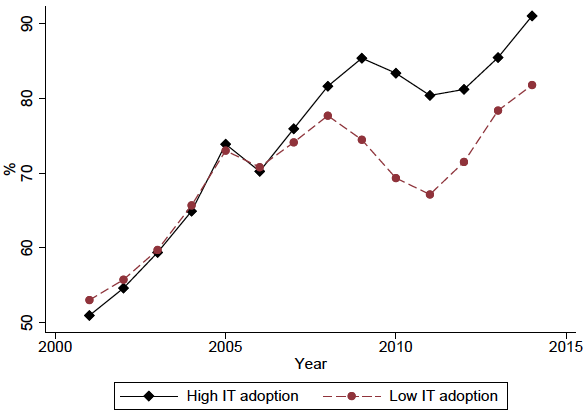The emergence of financial technology (FinTech) has triggered a debate on the effect of information technology on financial stability (FSB 2019, Claessens et al. 2018). The recent literature on FinTech has mostly focused on how the latest technological developments have been changing the way information is processed and the relative consequences for credit allocation and performance (e.g. Bartlett et al. 2019, Berg et al. 2019, Buchak et al. 2018, Di Maggio and Yao 2018, Fuster et al. 2019). However, the era of FinTech has not yet been exposed to large shocks testing its resilience. Therefore, the FinTech literature cannot directly speak to the link between technology and financial stability, as predictive systems which are accurate in good times may fail to predict default during a crisis (Rajan et al. 2015).
In our recent paper (Pierri and Timmer 2020), we shed light on how banks with a varying degree of pre-Global Crisis IT adoption fared when the crisis hit in order to understand the potential impact of technology adoption in lending on financial stability. To evaluate banks’ resilience, we study the evolution of their non-performing loans (NPLs) which are considered an important indicator of banking sector distress. The direction of the impact of IT adoption on banks’ resilience to a crisis is a priori ambiguous. On one hand, IT can improve monitoring and screening by enhancing the collection, storage, communication, and processing of information. On the other hand, banks with more IT might rely too much on ‘hard’ information, which are easier to report and communicate, inducing them to neglect ‘soft’ information and to take on too much risk (Rajan 2006).
Figure 1 illustrates the evolution of the ratio of NPLs to assets from 1996 to 2014 for banks in the bottom and top quartiles of the distribution of IT adoption. The two series are virtually indistinguishable until 2007. However, in 2008 – as NPLs start to surge – the two lines diverge. The growth in NPLs is considerably more pronounced for banks with low IT adoption. For example, in 2010, banks in the top 25% of IT adoption had about half of the NPLs compared to those in the bottom 25% of IT adoption. After 2010 the two series start converging again. The lack of correlation between IT adoption and non-performing loans outside the crisis reinforces the argument that it is important to study the effects of technology adoption in finance when the economy faces a system-wide shock.
Figure 1 NPLs over assets by pre-Global Crisis IT adoption
Note: Figure 1: NPLs over Assets by pre-GFC IT adoption. This Figure plots the median share of NPLs over assets for high and low IT adopters. “High IT adoption" is the median share of NPLs over assets for banks with IT above the 75th percentile. “Low IT adoption" is the median share of NPLs over assets for banks with IT below the 25th percentile.
Figure 2 plots the share of total loans (normalised by pre-Global Crisis assets) for banks in the high and low IT adoption groups. We find that banks that adopted less IT before the crisis also provided less credit, suggesting real effects for the economy.
Figure 2 Loans over pre-crisis assets by pre-Global Crisis IT-adoption
Note: This Figure plots the median share of total loans scaled by average pre-crisis (2001-2006) assets for high and low IT adopters. “High IT adoption" is the median share of Loan over pre-crisis assets for banks with IT above the 75th percentile. “Low IT adoption” is the median share of Loan over pre-crisis assets for banks with IT below the 25th percentile.
Measure of IT adoption
Our measure of IT adoption in banking is closely related to several seminal papers on IT adoption for non-financial firms, such as Bloom et al. (2012) or Beaudry et al. (2010). Following this literature, we use the ratio of computers per employee within a branch as the relevant measure of branch-level IT adoption for the years 1999 to 2006. We then map the bank branches to bank holding companies (BHCs) to construct a bank-level measure of pre-crisis IT adoption. In a later year (2016) we also have information on IT budgets and on the presence of new technologies, such as Cloud Computing, and we find a strong correlation between the ratio of computers per employee and these alternative measures.
Channel
Interestingly, tech-oriented banks were not ‘ex ante’ more exposed to the crisis due to their geographical footprint or their business model. Hence, to understand how high-IT-adopters succeeded in containing the surge of NPLs, we analyse the performance of mortgages originated before 2007 and sold to Freddie Mac, one of the two large government-sponsored enterprises (GSEs). We find that mortgages originated by high-IT-adoption banks were significantly less likely to be delinquent during the Global Crisis. Therefore, the better performance of high IT adopters during the crisis is driven – at least in part – by better screening of borrowers at the origin.
These results have important implications for financial stability. If high IT adopters were only better in offloading their bad loans to GSEs, then IT intensity would not enhance financial stability but instead lead to risk-shifting and exacerbate moral hazard.
The roots of IT adoption
Personal characteristics and experience of leaders matter for the outcomes of their organisations (Benmelech and Frydman 2015). We apply a simple text-analysis algorithm to the biographies of banks’ top executives hired before 2007. We search for specific tech-related keywords and use them to measure the managers’ predisposition toward IT. We find that banks led by more ‘tech-oriented’ executives adopted IT more intensively and experienced lower NPLs during the crisis. These findings support the hypothesis that IT adoption in banking, which can be partly caused by executives’ personal experience and inclinations, led to more resilience during the crisis.
Conclusion
As the financial industry becomes more and more reliant on IT, as exemplified by the rise of FinTech players, it is extremely policy-relevant to understand the consequences of a more intense use of IT in lending decisions for financial stability. We find that IT adoption enhances banks’ resilience to a financial crisis. The main caveat of our analysis is that the technologies adopted by commercial banks before the Global Crisis might be significantly different than the ones that banks, FinTech firms, and financial arms of ‘BigTech’ companies are implementing nowadays. However, if one focuses on the lending business, there are several commonalities between the IT-intensive methods adopted in the early 2000s and the most recent advancements. For instance, borrowers’ digital footprint can be an additional input for the traditional credit scores and improve risk assessment. Moreover, statistical models to predict defaults were widely used during the decade preceding the Global Crisis. The up-to-date machine learning techniques that are used to predict borrowers' behaviour are more powerful versions of the previously available statistical tools, rather than radically different systems. Therefore, and despite this caveat, our results suggest that the ‘FinTech era’ is likely to be beneficial to financial stability.
Authors’ note: The views expressed herein are those of the author and should not be attributed to the IMF, its Executive Board, or its management.
References
Bartlett, R, A Morse, R Stanton and N Wallace (2018), “Consumer-Lending Discrimination in the Era of FinTech”, University of California, Berkeley, unpublished working paper.
Beaudry, P, M Doms and E Lewis (2010), “Should the personal computer be considered a technological revolution? Evidence from US metropolitan areas”, Journal of Political Economy 118(5): 988–1036.
Benmelech, E and C Frydman (2015), “Military CEOs”, Journal of Financial Economics 117(1): 43-59.
Berg, T, V Burg, A Gombovic and M Puri (2019), “On the rise of FinTechs–Credit scoring using digital footprints”, The Review of Financial Studies (20190912).
Bloom, N, R Sadun, and J Van Reenen (2012), “Americans do IT better: US multinationals and the productivity miracle”, American Economic Review 102(1): 167-101.
Buchak, G, G Matvos, T Piskorski and A Seru (2018), “Fintech, regulatory arbitrage, and the rise of shadow banks”, Journal of Financial Economics 130(3): 453-483.
Claessens, S, J Frost, G Turner, and F Zhu (2018), “Fintech credit markets around the world: size, drivers and policy issues”, BIS Quarterly Review.
Di Maggio, M and V W Yao (2018), “FinTech Borrowers: Lax-Screening or Cream-Skimming?”, Working Paper.
FSB (2019), FinTech and market structure in financial services: Market developments and potential financial stability implications, Basel: Financial Stability Board.
Fuster, A, M Plosser, P Schnabl, and J Vickery (2019), “The role of technology in mortgage lending”, The Review of Financial Studies 32(5): 1854-1899.
Pierri, N and Y Timmer (2020), “Tech in Fin before FinTech: Blessing or Curse for Financial Stability?”, IMF, Working Paper.
Rajan, U, A Seru, and V Vig (2015), “The failure of models that predict failure: Distance, incentives, and defaults”, Journal of Financial Economics 115(2): 237-260.
Rajan, R G (2006), “Has finance made the world riskier?”, European Financial Management 12(4): 499-533.





